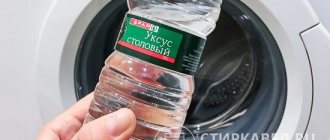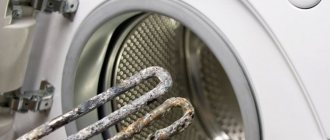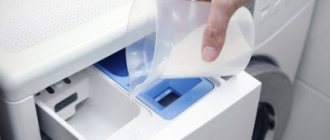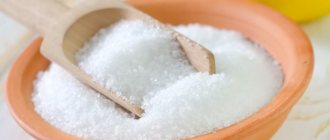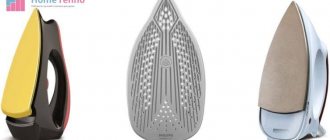The LG automatic washing machine is a reliable household appliance that helps keep clothes and other textiles clean. But the washing machine itself also needs care.
Constant use of the machine for washing various things, its presence in a damp room and loads are the factors that contribute to the formation of scale, blockages and mold.
Why and how you can clean an LG washing machine, we will tell you in this article.
Why is cleaning necessary?
If you do not pay attention to the LG washing machine, then over time the following unpleasant manifestations will make themselves felt:
- the appearance of the household appliance itself will become unattractive;
- the quality of the wash will begin to deteriorate;
- the equipment will malfunction and may even fail very quickly;
- there will be mold in the machine;
- An unpleasant odor will appear from the drum.
The following factors can aggravate the situation:
- poor water quality;
- using unsuitable detergents;
- constant washing only with low water heating, which makes it difficult to properly break down and remove fats and other pollutants;
- violation of the rules for operating the washing machine.
Maintenance of washing household appliances must be regular and of high quality.
Which machines support the cleaning function?
LG boasts a wide range of washing machines. But the function we are interested in is not present in every model. The main thing is that the cost does not change much in the presence or absence of such an opportunity.
Description of budget options
LG F1048ND.
Supports 22 additional functions, together with 9 main programs. A narrow variety of machines, the drum is cleaned automatically.
LG F1280ND5.
Silver model. Supports 22 additional modes, main programs – 14.
LG F1280NDS.
The model has small dimensions in width and supports steam and hypoallergenic washing.
Mid-level price category
- LG F-1296ND3.
Supports up to 1200 rpm, additional laundry loading function. Easily supports baby wash and delicate fabrics, removes stains. Prevents additional stains from appearing on clothes.
- FH 2A8HDS4.
Applies to narrow models. Capacity is up to 7 kilograms. There is an inverter motor, which also helps support a large number of modes and functions.
- F-14U2TDH1N.
The machine can easily accommodate up to 8 kilograms of laundry. The device can dry up to 5 kilograms of clothes, in addition to the normal cleaning function. Smart diagnostics is one of the additional useful options.
- F-10B8ND.
Capable of washing up to 1000 per minute when there is up to 6 kilograms of laundry inside. There is additional protection against leaks, together with mobile diagnostics.
How to enable the self-cleaning function?
The self-cleaning function is intended for preventive treatment of the washing machine. On average, it is useful to activate this mode once a month. It helps prevent blockages and removes deposits and small debris.
Some models of LG washing machines themselves offer self-cleaning after a certain number of cycles. Information about this is provided in the form of “tei” coding on the display .
You can force the appearance of this code by pressing and holding the buttons marked with the “*” symbol for several seconds or by pressing the self-cleaning button, which is located separately in some models.
Before starting self-cleaning, make sure that there are no items in the drum and that there is no detergent in the powder receptacle.
Further steps to start the process:
- Close the hatch door.
- If the user agrees to self-cleaning the washing machine, you should confirm your decision by pressing the “start” button.
- Wait for the cleaning cycle to complete. After this, ventilate the car and wipe off excess moisture.
Despite the fact that the self-cleaning mode is similar to regular washing, it has its own characteristics:
- Do not add detergent;
- The water heating temperature of the machine is set by default - 60ºС;
- rinse thoroughly with large volumes of water;
- The treatment is quite long - 95 minutes.
Not all LG washing machines have a self-cleaning option. In those machines that do not provide it, you can organize cleaning yourself by running it on a long mode, for example, “Cotton” at 60°C with additional rinsing.
In this case, just as with self-cleaning, the following rules must be followed:
- There is no need to add detergent.
- There should be no items in the drum.
It is advisable to run the self-cleaning mode in order to refresh the drum after washing rugs, etc.
How to enable the drum cleaning function in an LG washing machine, video instructions:
What causes the washing machine drum to become dirty?
Various factors can contribute to dirt getting into the outside of the drum. Let's take a closer look at the most common ones.
Sand and other hard dust from clothes
We immerse dirty laundry in the washing machine drum to make it clean. But few people think about the fact that there is sand, hard dust or other particles on the clothes at the time of washing that are not washed off with water and are deposited on the drum of the washing device over time.
In addition, many of us forget to check our pockets for small debris, for example, paper clips, coins, pins, pieces of wire, etc. This applies to work clothes in which a person spends a lot of time at work.
Also, dirty clothes may contain traces of grease or machine oil, which, in turn, gets on the walls of the device, creating favorable conditions for the growth of bacteria or the formation of mold.
To avoid negative consequences and early drum failure, always check clothing pockets before loading, and shake off any debris or solid dust from laundry before placing it in the washing machine. In addition, it will be useful to use a special washing bag, which will prevent threads and small pieces of fabric from getting into the washing drum.
Scale
Regardless of the quality of the chemicals used for washing, scale will form on the walls over time. In accessible places it is not difficult to remove, but, as a rule, there is a chance of scale penetrating into other parts of the device and heating elements.
The main reason for its formation is the salts contained in the water. It is recommended to add special water softening agents to the powder before each start. According to experts, chemicals harm the washing machine and recommend the use of high-quality filters that purify water.
Body and door: do they need to be washed?
The body of an LG washing machine also gets dirty over time. Dust settles on it, soap and other splashes get on it, and fingerprints remain.
For care, sponges, microfiber cloths and rags are used , which can absorb moisture well. Suitable cleaning agents include preparations that are intended for the care of household appliances, as well as a soap solution.
The hatch door should be washed both outside and inside, using both napkins and a melamine sponge for these purposes.
To clean the exterior of the washing machine, do not use tools with an abrasive or sharp surface, such as metal scrapers and knives, as they can damage the coating.
How to clean such a difficult place to clean as the rubber of a washing machine hatch - you can watch the video:
What substances can be used for cleaning?
You can use popular recommendations to get rid of dirt if there is no cleaning function
Special chemicals also help, but they must be selected with extreme caution
Here are just a few acceptable “helpers” in solving the problem:
- Vinegar.
- Soda.
- Lemon acid.
Each option has negative and positive sides.
Application of citric acid
This is the most common product used to remove scale, mold, and traces of grease. It is enough to take 200 grams of dry acid powder to perform one cleaning procedure. When using such tools, the advantages will be as follows:
- Possibility to use automatic drum cleaning mode.
- Safety for constituent components.
- Availability.
- Low cost.
The disadvantage is that citric acid will not be effective if the contamination case is particularly severe. It will be difficult to clean the inside of the device if the drum has not been cleaned for many years. It will be necessary to apply citric acid several times, or choose another method that is more effective.
Using baking soda
Baking soda is suitable for getting rid of dirt accumulated on the walls. But the tank and heating elements will require other methods.
The procedure involves using only 150 grams of the substance.
The method has the following advantages:
- Safety of machine parts.
- Efficient in drum cleaning.
- Availability.
- Low cost.
The disadvantages are that the cleaning process is done manually. In addition, you need to wait a certain time for the soda to interact with water.
Using baking soda requires following the following sequence:
- The walls of the machine are slightly moistened. But you can’t moisten it with plenty of water.
- Pour a little product onto a rag.
- We wait half an hour until the active substances begin to interact with each other.
- Dirt is completely removed with a cloth.
What about vinegar?
This is a concentrated substance that can be used to clean various parts of washing machines. 50 milliliters of the product are diluted with the addition of 150 ml of water. Vinegar essence cannot be used without such dilution.
The cleansing process does not require additional actions from the user. The product has a low price. The procedure is also effective. But vinegar is quite difficult to wash out of the inside of the drum. Rubber parts of cars may be damaged by the substance.
Why does the powder receptacle become dirty?
The powder receptacle of your LG washing machine can also become dirty. Dust gets into it, incompletely washed residues of detergents and air conditioner may linger in it, and water leaves a limescale deposit.
The most convenient way to put the cuvette in order is to take it out of the machine (read how to do this here). For proper cleaning, you can use a small brush. For example, an old toothbrush.
The best option is to prepare a concentrated solution of citric acid in a basin and soak the entire tray for several hours. After this, clean it intensively with a brush.
It is advisable to wash not only the tray, but also the opening into which it is inserted. To do this, it is convenient to use a damp sponge with citric acid powder applied to it. After wiping, the surfaces should be rinsed with water.
Pros and cons of cleaning with citric acid
The properties of citric acid are determined by its chemical structure. This substance was not invented specifically for cleaning washing machines, so its effect on equipment parts has both positive and negative sides.
Positive aspects of the method
Without cleaning the scale in the SM, you can expect, at a minimum, burnout and the need to replace the heating element. Therefore, there is no need to delay the cleaning procedure. The method for removing deposits should allow anyone without experience to carry out the procedure.
If you decide to regularly clean your SM with citric acid, you can buy a large volume of it at once. It will be cheaper and less troublesome
The use of citric acid to eliminate accumulated insoluble salts meets this requirement due to a number of advantages:
- Availability and low cost. Citric acid in the required quantity can be bought in any store for several tens of rubles.
- Simplicity. Even an untrained person can carry out the cleaning procedure.
- Efficiency. 100 g of citric acid will dissolve up to 80 g of scale.
- Safety. Both citric acid and calcium citrate formed after dissolving scale are harmless to health.
These positive aspects of LC make it the drug of choice in the fight against scale. There is no point in buying expensive special products for cleaning SM if they provide a similar effect.
Citric acid is used both in caring for the internal and external parts of the washing machine. The advantage of this folk remedy is that using lemon juice can effectively clean surfaces that are inaccessible to the user.
Confirmation of the effectiveness of removing accumulations with citric acid is demonstrated in the video:
Negative effects of citric acid
There are legends about the negative effect of citric acid on internal parts when cleaning a washing machine. Numerous arguments are given against this method, but little evidence is provided.
The theoretical claims of people regarding cleaning SM with citric acid are:
- The formation of salts that remain in the washing machine and can clog the drain.
- The acid corrodes the metal components of the heating element.
- Rubber seals soften and may crack.
- After cleaning, things develop a specific smell.
To remove scale from the SM, a 1% solution of citric acid is used.
For comparison, a 10% solution of aggressive hydrochloric acid is used to clean water heating boilers from deposits. And even multiple treatments with such a strong agent do not affect the operation of the equipment. And rubber is generally resistant to short-term exposure to weak acids.
The problem will arise if crystals or citric acid solution remain in the pocket of the rubber seal that seals the door. In other cases, the negative effect of citric acid on the insides of the washing machine is a myth.
Holes in the cuff from citric acid do not appear immediately, but only after multiple descaling sessions without following basic rules
The salts formed during descaling, together with the remaining lacquer, are completely removed by subsequent two or three rinses, leaving neither odor nor sediment.
Are all the disadvantages of citric acid really far-fetched? No, descaling has one more drawback, but it is common to all cleaning products.
Insoluble salts can accumulate at water leaks, temporarily closing the hole and eliminating the problem. After cleaning the washing machine, the leak may appear again. The described problem is not caused by citric acid or other means, but you should be aware of the possibility of its occurrence.
The consequences of using LC for cleaning SM are presented in the video:
Cleaning the filter
The drain filter of an LG washing machine is a unit that traps small debris and debris, preventing them from reaching the pump.
No matter how carefully the clothes are sorted and inspected before placing them in the drum, it will not be possible to completely prevent the formation of debris in the filter .
It contains lint and hair from clothes, forgotten coins, paper clips and other items from pockets. Cleaning the filter is an important preventive measure that contributes to the normal operation of the washing machine, prevents clogging and the appearance of an unpleasant odor from the drum.
It is recommended to carry out cleaning once every few months, and when washing clothes with lint - unscheduled. Access to the filter is located on the front side of the washing machine below, behind the panel. The part is removed and washed under running water or in a bucket, after which it is returned to its place. If you carry out such cleaning regularly, the process does not take much time and does not require effort. Read how to do this here.
Some useful tips and operating rules
Sometimes water leaks when cleaning is completed. In most cases, the cause of the malfunction is a poorly tightened filter. In this case, you need to unscrew it again and carefully put it back in place. It is also possible that the gasket was too worn.
It is useful to take measures to prevent blockages. To do this, it is recommended to do the following:
- Filters must be cleaned on a regular basis. In this case, dirt will accumulate in them to a minimum extent.
- You need to inspect the clothes being washed and the water for small objects that could clog the machine drain. It is necessary to check the pockets and how tightly the buttons are sewn.
- You need to choose the best quality laundry powder and conditioner available to use.
- If you need to wash clothes that have small parts (for example, beads), it is recommended to do this in a special bag.
Proper care of equipment will extend the life of the washing machine.
Removing scale from heating elements
The formation of scale on the heating element is an inevitable process . The appearance of plaque is promoted by high temperature, the detergent itself and impurities that are in the water.
In addition to lime, threads and fibers from fabric can literally be welded onto the heating element. As a result, the heating element begins to become overgrown with a thick layer of scale and, as a result, breaks.
To keep the heating element clean, it is necessary to carry out regular cleaning. Both store-bought products and folk recipes are suitable for this purpose.
Soda and vinegar
This recipe has a peculiarity of application - the ingredients are not mixed immediately. Procedure:
- in a bowl, mix ½ pack of soda with water to form a thin paste;
- pour the resulting mixture into the powder receiver compartment;
- measure 1 cup of vinegar and pour it into the drum;
- close the hatch door;
- select the “cotton” mode, set the maximum temperature and long cycle;
- install additional rinse;
- start the washing machine;
- ventilate the drum.
If the washing machine has not been cleaned for a long time, after the cycle has completed, you can run the rinse only again to thoroughly rinse the tank and remove any remaining dirt.
Lemon acid
To clean your LG machine from scale and deposits, you can use citric acid. Rules of application:
- Make sure there is no laundry in the washing machine.
- Close the hatch door.
- Pour 150 grams of citric acid into the vice compartment of the powder receiver.
- Select the “Cotton” washing program and set the maximum temperature.
- Start the program.
- After finishing washing, ventilate the drum.
The cleaning method using citric acid will be useful, especially in cases where the tap water is very hard. In this case, it is recommended to add citric acid even when selecting the self-cleaning function.
Industrial products
LG special cleaning products are ready-to-use preparations that can be purchased in hardware departments of stores or ordered in an online store. Such products are used strictly according to the instructions given on the packaging. Their main purpose is to combat scale and prevent the formation of mold.
Well-proven means of complex influence include the following products:
- Beckmann (Germany);
- Magic Power (Germany);
- Tiret (Poland);
- Sano Antikalk Scale Remover (Israel);
- Topperr 3004, 3233 (Germany).
Mechanical cleaning
If there is a suspicion that the heating element of the LG washing machine is in poor condition and is thoroughly overgrown with scale, dry cleaning cannot be carried out. This warning is associated with the danger that pieces of sediment will literally fall off the heating element and get into the drainage units, and also begin to contaminate the laundry being washed.
The way out of this situation is to remove the heating element and clean it separately. To do this, you will have to partially disassemble the washing machine and gain access to the part from the rear wall.
The removed heating element can be tested with a multimeter. If performance is unsatisfactory, it may even be necessary to replace the part rather than clean it.
Procedure:
Rinse the heating element in hot water, trying to remove large deposits with a sponge and hands. Abrasive brushes, sandpaper and other similar tools should not be used to avoid damaging the heating element.- After large pieces of scale have been removed, it is necessary to treat the part chemically.
In a 1.5 liter plastic bottle, the top part is cut off so that the spiral part of the heating element can be lowered inside. - Pour 4 tablespoons of citric acid into the bottle and add hot water.
- Stir the solution.
- Place the heating element into the solution.
- Leave to act for a day.
- Clean with a sponge.
- Rinse.
- Place it back in the washing machine.
After the heating element has been removed to put it in order, it is advisable to inspect the lower part of the tank through the groove into which the removed part was placed. If there is debris there, it should be removed.
Tips for carrying out complex cleanings
Mold, unpleasant odors and dirt are problems that every equipment owner faces. You should regularly maintain the cleanliness of the elements located inside the device.
Washing the drum
Combining disinfectants with idle circulation is one possible solution to this problem. Regular citric acid can also be used. It is recommended to clean the rubber band only by hand.
The simplest processing option requires the following requirements:
- Carefully push the folds apart.
- Wash the cuff around the circumference. We use a sponge, soap, warm water.
- Wipe the surface of the part dry.
A solution of copper sulfate is used if the owner notices the appearance of mold spots. Another acceptable remedy is to prepare a cleaning paste that includes water and baking soda in equal proportions.
The purpose of the composition is to process not only rubber bands, but also the entire drum. The machines are kept in this position for two hours, then we wipe them with a sponge and start the long-term wash mode.
Working with filters and drainage hoses
An unpleasant odor is often caused by dirt particles that remain virtually invisible to the human eye. This is especially true for debris that could not be removed from clothing in time before being placed inside. It is recommended to clean drain filters at least once every three months. If the exploitation is active, then the work is carried out more often.
The operation involves removing the protective panel and a small container into which water flows. You can protect the floor with a cloth. The filter is unscrewed using counterclockwise movements. Then there is washing, with water under high pressure, the accumulated debris is removed from the hole.
When cleaning, the hose is simply disconnected from the parts to which it previously fits. The design and features of the part depend on which specific model of equipment is used by a particular buyer. If there are vertical models, the hose can only be reached using the side cover.
Preventing blockages
The following preventive measures will help prevent blockages:
- Do not allow foreign objects to enter the drum. All pockets must be checked in advance, loose buttons must be sewn on, etc.
- Washing items stained with technical oils is not advisable, since substances partially washed off from the fabric are deposited on the components of the washing machine.
- Washing items with long, loose pile and a lot of pilling can lead to clogs.
- For washing in an automatic machine, you must choose only those detergents that are intended for this purpose. Using regular soap shavings, for example, can cause detergent to stick and cause a clog.
- From time to time, at least once a week, washing should be done at a high temperature of 60°C.
- Using water softeners will prevent the formation of strong limescale in hard tap water.
- It is advisable to clean with vinegar or citric acid once every 2-3 months.
- The drum should not be used as a place to store dirty items. Laundry baskets are suitable for these purposes.
- Already washed clothes should not be kept in the drum for a long time.
Why is a “dirty” drum dangerous?
Scale and mold, as we have already found out, are the main “enemies” of the automatic machine, which must be actively combated. It is the drum that is the most vulnerable part of the SMA in terms of the deposition of such formations on it.
The moisture and heat that are constantly present in it create ideal conditions for the proliferation of harmful microorganisms inside the device and the further appearance of mold. An unpleasant odor on washed clothes is the first sign that the washing machine needs disinfection. This situation is not dangerous for the washing machine itself, but sooner or later it will affect the health of its owners in the form of an allergic reaction.
A potential threat to SMA components comes from scale. Its formation is facilitated by the use of water with a high content of mineral salts. Limescale, affecting the main functional components of the SMA, reduces the efficiency of its operation, and therefore the quality of the wash itself. The problem will be solved by simply cleaning the device with special cleaners or substances that can remove harmful formations.
About the basic washing programs of Veko options
- 40'40° halving the washing time - 40 minutes, not 80, which is facilitated by the additional revolutions of the Beko machine drum and a constant temperature of 40 degrees,
- Delicate washing mode for knitwear and viscose products, implying smooth drum movements. The program protects the material from abrasion and the color from fading,
- for children's clothing, several washing and rinsing cycles are combined, the mode is optimal for the clothes of those who suffer from allergic manifestations,
- a special program for dark fabrics involves low temperature and low spin speed with a large volume of water to protect items from possible shedding; for maximum effect, it is recommended to use detergent products in liquid form,
- For cashmere and silk, the Beko machine has a hand wash cycle that uses less water. This blocks increased moisture absorption of fabric fibers and protects them from deformation and stretching,
- The mode for woolen products allows for the most gentle care for them, protecting them from pilling and matting,
- mode for goods with down and feather fillings - for options with a drum capacity of 9 kilograms or more. Along with washing things, feather mites and their metabolic products are eliminated,
- The Beko washing machine's self-cleaning program treats the hoses, drum and detergent trays at a temperature of 70 degrees, removing mold,
- the shirt washing mode helps in washing problem areas of products without damaging the material, drum speeds maintain balance at a temperature of no more than 40 degrees,
- fitness program - for processing sportswear made of cotton and synthetics at a temperature of 40 degrees,
- eco 20°C – for items made of cotton fabrics with slight dirt. Saves up to 80% of energy when compared to a standard cotton cycle, and liquid or gel laundry products are the optimal solution.
Models of machines with “drum cleaning”
Not all LG washing machines have a “drum cleaning” function. The presence of this function does not affect the price of the unit. Here are examples of budget washing machines with a similar program:
- LG F1048ND is a narrow model with 9 built-in washing programs and 22 additional options, including automatic drum cleaning.
- LG F1280ND5 is also a narrow washing machine with the ability to choose one of 14 programs and 22 additional functions; the machine has a stylish silver design.
- The LG F1280NDS is another slimline washing machine that, in addition to regular washing modes, has the option of steam washing, as well as hypoallergenic washing.
Peculiarities
The South Korean company LG first released washing machines with the function of steaming clothes in 2005, however, such units appeared on the Russian market later, due to which our consumers still do not have a very good idea of the difference between conventional washing equipment and devices equipped with the True function Steam.
The fact is that in an ordinary washing machine, which does not include this innovative technology, the temperature of the water in the drum is not the same, and allergens have the opportunity to “hide” in its colder part. In order to heat the laundry evenly, it is necessary to ensure a constant temperature of 60 degrees for 30 minutes, which becomes possible when using an LG washing machine with a steam function.
Tiny organic and inorganic particles penetrate deep into the fibers of the fabric, which complicates the process of washing clothes, since it is quite difficult for washing powder to reach such stubborn contaminants. A special steam washing mode comes to the rescue, during which hot steam freely penetrates between the fibers of the fabric, destroying foreign particles, destroying allergens, bacteria and foreign odors.
Let us list the main advantages of LG washing machines with steam function.
- Improved washing quality by 20% compared to conventional washing machines.
- Economical operation - this result is achieved due to the fact that steam generation requires several times less water than for conventional washing, in addition, the operating time of the washing machine is significantly reduced, which also reduces energy consumption.
- The effectiveness of washing the thinnest fabrics - it has been noted that the True Steam function is best suited for delicate washing, since treating laundry with hot steam is similar to boiling it, and in addition, the fabrics do not fade or become deformed.
- This option completely replaces pre-soaking the laundry, while being much more effective. Linen treated with hot steam washes much better.
- The ability to destroy microscopic mites living in different types of tissue. You just need to turn on the “steam effect” option, which will destroy these harmful inhabitants and disinfect your laundry without washing with water.
- Treating linen and clothing with hot steam removes bacteria and allergens from items.
- This function helps to refresh and free laundry from small wrinkles, perfectly preparing items for their subsequent ironing.
Some users also mention the disadvantages of such washing machines.
- The True Steam function is unavailable for some laundry washing modes.
- Not all types of stains can be removed using this technology.
- This function does not replace ironing, but only makes it easier (however, no instructions for such machines say otherwise).
- After steam treatment, laundry remains slightly damp and requires additional drying. However, some LG brand washing machines with steam treatment also have a laundry drying function, which, of course, affects the price of such units.
- Quite a high price for LG machines with True Steam capability. However, many of their owners note that the game is worth the candle - high-quality washing, clean laundry free of bacteria and allergens, and economical operation fully pay for the additional costs of purchasing such a washing machine.
Thus, we can conclude that such washing machines have much more positive aspects compared to negative ones. Such smart cars are in great demand among buyers both in our country and abroad.
How to set the desired mode?
The selection is made using the programmer knob. There are inscriptions and icons around the selector switch. On older models there are no verbal designations - only icons, hence the problems with choice. It happens that the owners of the machines do not understand the images, then they need instructions to decipher the symbols. In the new models, the manufacturer took this omission into account - all icons are duplicated with words.
Before you set the mode, you need to sort the things that you are going to wash. Evaluate them by type of fabric, color, degree of soiling. Taking these positions into account, a decision is made: choose a ready-made program or customize your own. If preference falls on the second option, then the user selects:
- temperature;
- duration of the process;
- rotational speed.
Whether a ready-made program is included or your own is being configured, the user can add additionally:
- soak;
- rinsing;
- light ironing;
- spin
The process can be delayed for a certain time, depending on the duration of the timer. Typically, the maximum delayed start time is 24 hours. Descriptions of the modes can be read in the instructions.
- How to use a Vestel automatic washing machine correctly? User manual
What does Indesit offer?
Mode is a process characterized by certain conditions. The temperature, drum rotation speed, time and goal vary. A program is a specific procedure, which, differing in washing conditions, can consist of several modes.
Basic
- Cotton. T-shirt or cotton box drawn. The user can select options with different temperatures and durations:
- 90–95 degrees is a good option if you need to wash stained kitchen towels. The drum is fully loaded. And the cycle time is almost 3 hours.
- 60 degrees. With intensive washing, the process is shorter, since the soaking step is eliminated. Duration is reduced to 2.5 hours. This option is chosen for heavily soiled white items - tablecloths, towels, bed linen.
- 40 degrees. Recommended for colored products. Duration - about 2.5 hours.
- Synthetics. A flask with temperature indication is shown. There are two options:
- 60 °C - 1 hour 25 minutes.
- 40 °C - gentle version, lasting 1 hour 11 minutes. Loading - 50%. This is usually 2.5–3.5 kg, depending on the model.
- Wool. A skein of thread is drawn. For wool and cashmere items. Duration - 55 minutes. Temperature: 40°C. Spin speed is reduced.
- Silk. The picture shows a T-shirt. For curtains made of thin fabrics, for viscose and underwear. They are washed at 30°C for 55 minutes. Load the drum by about 20% - up to 1–1.5 kg. There is no spin.
Some models may contain separate modes, without an emphasis on fabric. Washing available:
- Preliminary. Use instead of soaking. Gently rotate in slightly warm (30 °C) water.
- Daily (everyday) is a standard program for quickly washing lightly soiled items.
- Intense. For cotton and linen. Hot water - up to 95 °C. This is an analogue of “cotton 90 °C”.
- Delicate - similar to “wool”. You can wash completely different fabrics that have one thing in common - special requirements for process conditions. Wool, organza, lycra and other delicate materials are washed at 40 degrees.
Additional
They are chosen for specific items, taking into account the fabric and degree of contamination:
- Washing modes and times in the Atlant washing machine
- Jeans. The icon matches the name. Created specifically for denim products. Wash at 40 degrees. Loading - up to 2.5 kg. Drum speed is reduced.
- Quick wash mode. The picture is a clock. The express version allows you to wash things in a quarter of an hour. Loading - about one and a half kg. Temperature: 30°C.
- Shoes. The picture shows a sneaker. Designed for sports shoes - sneakers, suede sneakers. Wash in lukewarm water, two pairs at a time. Cycle duration: 50 minutes.
- Sportswear. There are models with two options - regular and intensive. The water is heated to 30 °C. Time - 1 hour 20 minutes.
SMA "Indesit" also has special functions:
- additional rinse - intuitive designation - variations on the theme of drops and a basin of water;
- spin - a pattern in the form of a twisted spiral;
- Eco Time - reduces time and water consumption. Compatible with synthetics and cotton 40.
- easy ironing - iron drawn;
- delayed start - icon with a clock.

